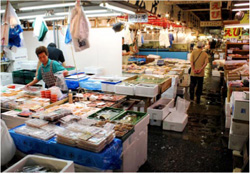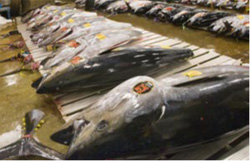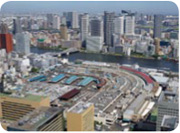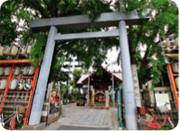Home > Highlighting JAPAN > Highlighting Japan OCTOBER 2012 > Tsukiji Market
Highlighting JAPAN
[SERIES] STUDENTS'CORNER: Ways of Japan
Tsukiji Market

One small corner of the vast Tsukiji Market
Tsukiji, after which the Market takes its name, is located near the mouth of the Sumida-gawa river that flows into Tokyo Bay. The land was reclaimed from the sea during the Edo period (1603–1867), during which time the area was lined with the homes of samurai warriors. The current Tsukiji Market opened in 1935, when the fish market in Nihonbashi relocated there due to the Great Kanto Earthquake of 1923.

Frozen whole tuna lined up for auction
The Tokyo Metropolitan Government is planning to relocate Tsukiji Fish Market to Toyosu, about one kilometer away, due to overcrowding on the current site and the aging of the facilities.
Note: Same-day registration is necessary to tour the wholesale tuna auction observation area. Registration starts at 5 a.m. at the Fish Information Center, with registration closing after access is granted to the first 120 people. Please be advised that if there are a lot of visitors, registration could end earlier.

Q1: Tsukiji Market's buildings form an arc. Why?
A. Because they were built around a railway station.
B. Because they were built around a park.
C. Because they were built around a castle.

Q2: There is a stone monument dedicated to a sushi-related food item at the Namiyoke Inari Jinja shrine next to Tsukiji Market. What is that item?
A. Rice
B. Eggs
C. Soy sauce
© 2009 Cabinet Office, Government of Japan






